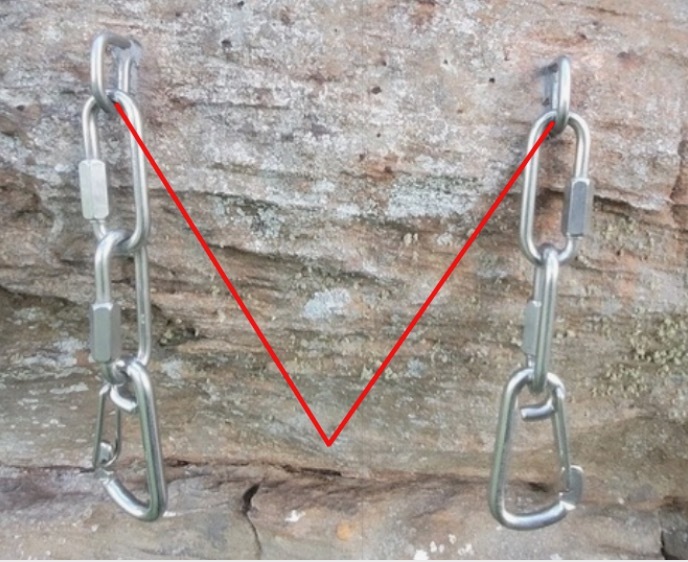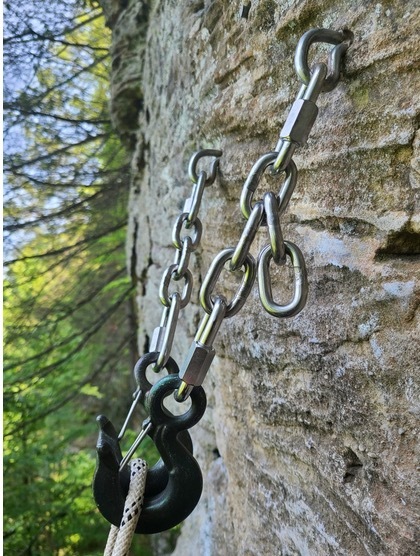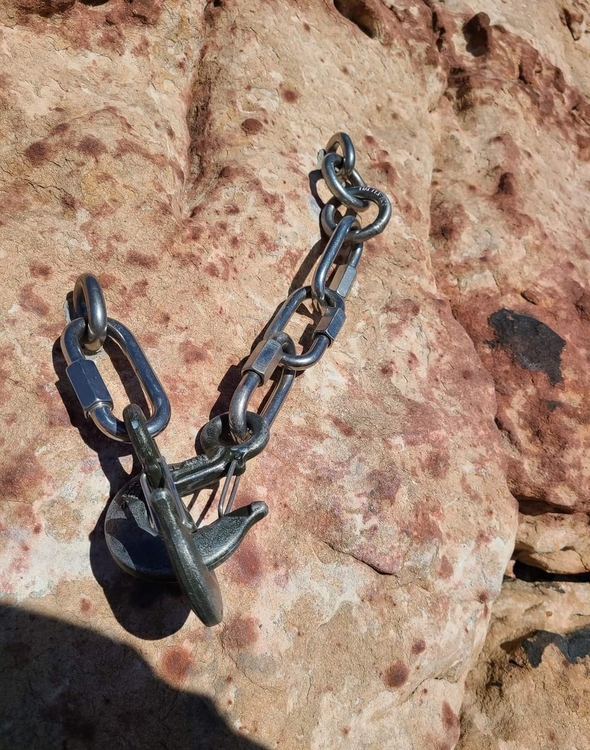Why are mussy hooks not installed opposite/opposed?
|
|
There was a recent accident involving a friend of mine and while we still do not know 100% what the cause was, our current extrapolation from what we do know and looking at the anchor is that the rope may have "backclipped" through the mussy hooks. This got me thinking about the aforementioned question. In looking through the Beautiful Hardware thread and from my own experience, it seems that the stainless steel carabiner/mussy hook (I think they are technically for marine use? photo below) anchors are often installed opposite/opposed, while rarely are mussy hooks installed in this manner. Is there a concern about the nose of the mussy rubbing on the rock? What if they are hanging in space? Is it simply ease of clipping? Something else entirely? And is there a safety-related downside to installing mussy hooks opposite/opposed? This photo of the anchor involved in the accident demonstrates how the nose of the mussy hook acts a bit like a basket that will easily receive the rope, leading to the backclip-esc unclipping of the rope. I would imagine this could be exacerbated if the mussy hooks are less extended and therefore less able to twist. I believe the mussy hooks are near waist-height when the climber is at the anchor, leading to the possibility of the climber's knot being able to lift the rope up and over the noses, as is being done by hand in the photo. Examples from the Beautiful Hardware thread illustrating the common difference between the SS marine(?) anchors and mussy hooks: |
|
|
In general I think the take is that if two hooks facing out the same direction is good enough for the insurance/litigation hell that is climbing gyms then it's good enough for outdoor routes. That being said, I certainly have seen anchors with hooks facing different directions outside. I understand your concern from the picture but something like that seems like it's only possible if you're at/above the anchor. And a big thing about mussy hooks is that you should never be climbing above them, especially if you have no other protection beneath them. I honestly hate cleaning TRs when it's a hook anchor for the same general concerns about potentially coming unclipped even though that chance is immensely small and would likely require some fuck ups on my part as a climber as well. Clipping them in the correct order for the direction your rope is running/where you're being lowered to helps alleviate a lot of that concern. |
|
|
Tal M wrote: Hard to climb above the anchors in the gym though. Even as it's true that it's not a great idea to do that outside, it's a much more real possibility. And yes, there are mussy anchors out there with opposed hooks, hence the "rarely installed" above. I think there's even one in the beautiful hardware thread. They don't seem common, but if they exist then clearly they aren't impossible.
All very true. How much is this weighed when developers install mussy hooks? I feel like when there are hooks they are often at a convenient waist height rather than up a little higher. I may just be picking those anchors out from my memory, though. And it seems like a lot of things we do in climbing are to avoid that one in a million chance of something going wrong, even if it's unlikely. Is this another one of those areas?
I think one of the big takeaways from this incident is to test your system before relying on it, precisely to avoid those potential mistakes. |
|
|
Will WB wrote: "Even as it's true that it's not a great idea to do that outside, it's a much more real possibility" - I think in the realm of "reducing risk" there's a level of responsibility that developers need to take and a level of responsibility that the climbers need to take (and the summation of this responsibility should add to over 100% of the total responsibility for climbing - climbers need to be able to assess the climb and not even start it if they feel it's unsafe, for example). If you are cleaning a TR, there is absolutely no reason for you to be climbing above the mussy hooks - bar none. The only reason I could see it for cleaning a lead would be if you're climbing above a bit and clipping low from a better hold - and if it fails in that situation, you should have pro beneath you in case the mussys unclip somehow. I don't believe in shifting the conversation towards dumbing down anchor hardware to the lowest common denominator climber. If we truly wanted to do that, let's install locking steel carabiners at every anchor, opposite and opposed. And while I have seen that before actually (shoutout to She's My Wife at Ten Sleep for being the most impossible to clip the rope directly into anchor of all time with opposite and opposed twist lock carabiners), it shouldn't be a requirement or even a reasonable expectation. As a result, I think your final statement is the big takeaway - climbers need to have the skills to clean anchors of a variety of types and configurations if they're going to be climbing outside and that includes always testing your new system before removing your old system. If you don't like the hook configuration, rap off the quicklink or chain that the hooks are into instead. Clip a draw to the anchor bolt and top out the formation and belay your second up. Traverse over to another anchor you like the look of better. Leave your own lockers at the anchor and come down off of those. Don't start up the route in the first place. You have a lot of options here - you're not required to use the hooks if you don't want to. Also, for what it's worth, "I feel like when there are hooks they are often at a convenient waist height rather than up a little higher." - I can't think of a single mussy hook anchor offhand that seemed to be intentionally installed near waist height - maybe some at chest height but generally they're going to be right near your face - at least around me. |
|
|
Tal M wrote: Well said. I think there can still be things that happen that are purely mistakes, though, even if the climber has made a sound assessment. So I guess I'm wondering, as someone who has barely dipped a toenail into route development, if there's a reason not to put mussy hooks opposed. You're bringing up the same hardware, it doesn't take more time, it doesn't mess with ease of clipping when you're pumped, it's just installing one hook the other way. I agree that things don't need to be "dumbed down to a lowest common denominator" and I think that would be an impossible mission anyway. But installing one hook backwards doesn't seem like a drastic dumbing down to me. Again, I'm not trying to say that anchors necessarily should be installed this way or that way, and I do think mussy hooks are a great anchor, just wondering if there's a way it's done because it's always been done like that or if there's a discussion about this among developers. And that anchor at Ten Sleep sounds awful to come across. My condolences. |
|
|
Will WB wrote: For reasons: your question "Is there a concern about the nose of the mussy rubbing on the rock?" is why. The route has to generally be either really overhanging or very extended out from the bolts and casually overhanging to not be rubbing due to their bulk. If the rock is fairly featured, there's concerns of the gate landing on a rock and opening the gate. The vast majority of route anchors meets one of these two criteria. Otherwise a lot of the reasons is just because it's what folks are used to. In the latter situation, it seems reasonable to re-think, to your point. I actually have a route I just equipped recently that might be overhanging enough to flip one of the hooks around and see if there's a reason to not leave it that way. |
|
|
To answer your question “Why are mussy hooks not installed opposite/opposed?” The following is the recommended installation for the ClimbTech mussy hooks from the American Safe Climbing Association: “Lower off-hooks are positioned perpendicular to the rock face, with both gates facing away from the rock. This prevents the possibility of the lower-off gate opening against the rock, and makes the lower-offs easier to clip. The large nose on the ClimbTech lower-off hook can cause interference and rope twisting if the lower-offs are opposed.” |
|
|
Anna nailed it! Every anchor system has potential for misuse, we switched over many of our anchors to hooks to reduce the related potential for error while conducting an anchor transition, as well as for convenience of the user. In doing this I think it's impossible to ignore that we also need lowered the perceived level of skill needed to safely clean the anchor. "You don't need to know how to clean, it's got drop ins." "All you have to do is switch the rope from the quickdraws to the mussys." Some basic level of understanding is needed to use the anchors properly, it's impossible to dumb it down enough for every potential user. Set up your own anchor or opposed quickdraws for top roping or anytime climbing above the anchors. (This is why ASCA doesn’t recommend using mussys when the anchor is used as an intermediate protection for a multipitch or route extension) Clip the components how they were designed to be clipped. Don't attempt to twist a mussy to oppose it if they were designed to be clipped both facing out. Always weight new systems while still connected to a loose tether or old anchor system. |
|
|
This winter I witnessed someone twist a mussy to attempt to oppose them with following result: Three other reason not to oppose is it makes the mussy facing the rock especially difficult to clip on routes where the mussy is attached directly to the bolt via one quicklink. Imagine the mussy on the lefthand bolt in the photo being reversed. Also notice the terribly inefficient setup of 3 quicklinks and 2 rap rings on the right hand anchor, use a bit of chain people! |
|
|
abandon moderation wrote: I'm not sure this is true - can you source this? |
|
|
I’ll leave this right here. HOW TO CORRECTLY USE LOWER OFF ANCHORS
|
|
|
Even when I’m climbing with a partner who will also lead the route, I always have the first leader build an anchor to lower off. The second person then leads, cleans our gear off the anchor and lowers off the fixed “community” lowering carabiners/hooks. One less wear on the fixed hardware goes a long way! |
|
|
Tal M wrote: Tal M: I guess it seemed to me that the massive nose of a mussy provides enough protection against the rock interfering with the gate barring incredibly featured rock, and when under tension (i.e. when they could cause the most damage to the rock) the hooks don't seem to contact the wall much. But again, I've hardly dipped a toenail into development so those were just suppositions. Fair enough, thanks for the responses. Anna, thanks for those links, I don't think I would have found them on my own. Good to see the literature on the intended use of the mussy hooks. DrRocks, yeah twisting the hooks to be opposed is definitely a bad idea. Good to point that out. Leaving the conversation of when to use the bolted anchor vs. personal gear anchor aside, this was a case of cleaning a cordallete/QD TR anchor and lowering through the hooks. |
|
|
grug g wrote: Anna found you a source, I will add an anecdote: I have seen 18-month old mussy hooks (the ClimbTech ones, which are b-e-e-e-e-e-e-f-y) that were 80% worn. Don't top rope through mussy hooks. |
|
|
Like yes, but also the ClimbTech Mussy's are very often cheaper than many regular aluminum quickdraw rope end carabiners. Especially so if we had a reasonable comparison of lifetime to top rope though per cost. |
|
|
For me, the only people who should be top-roping on lowering hardware are those people who are replacing the hardware and who act as stewards for those specific anchors. Everyone else should be building anchors with personal gear and only the last person lowers off the fixed “community” carabiners/mussy hooks after cleaning the anchor. |
|
|
Anna Brown wrote: Some areas specifically invite people to top rope through their mussies. The vast majority of areas do not, however. I have multiple crags that I frequent where this is the norm, but this is also because these areas aren't super popular and will never be. |
|
|
grug g wrote: What? LOL. NO FIXED HARDWARE should ever be used for top roping. Use me as the source. |
|
|
Anchor hooks are placed with gates out for a couple reasons. If opposed the inward facing hook tends to gouge into the rock and scar it up, along with often orienting strangely to wear much faster on the nose or even get pushed into the bottom of the wiregate. If they are extended with chains to lay flat and opposed the rope gets pinched behind the hooks and wears unnecessarily/grooves the rock. If the hooks are placed in very overhanging terrain this ceases to be a problem, but the opposition of the hooks still causes more friction on ropes and the hooks themselves, so we feel that because they are being used for lowering and the climber will always be beneath them gates out is the ideal configuration. Some area developers and LCO's may encourage folks to just TR straight off the hardware to simplify everything and reduce potential for accidents... this is generally not the intent of lower offs as there is higher potential to somehow unclip the rope accidently. If this is something that folks insist on doing it is surely a good idea to add a locking draw for backup or something along those lines to add redundancy to the system. Obviously this all is dependent on the climber never being above the hooks - trying to clip into the system from the top of the cliff then downclimbing to hang a toprope being a particularly dangerous scenario. There are many ways to dangerously misconfigure any anchor system and there will be no way to protect against all of them, but it is important that when a equipper places any type of anchor they consider how they are normally accessed. As referenced by Anna above we have some guidelines on our Lower Off Initiative page detailing what to do if climbing above, etc. Also, just as a matter of language, we refer to the ClimbTech wiregate hook as an "Anchor Hook" and the old style ones with the crappy gate as a "Mussy Hook", this is commonly misused but we stick to it as there is a difference and the Anchor Hook is purpose built for climbing applications with a stainless steel wiregate. |
|
|
Also, if you appreciate lower-off anchors on single pitch routes across the country, our Lower Off Initiative fundraiser goes through the end of the month and donations are currently being matched. |
|
|
Nate Liles wrote: Do you know if this is true for non-CT hooks? I have a lot of steel wiregates I use for anchors in areas that see lower usage where minimizing visual impact is more important and I can’t think of why it would be notably different friction-wise than normal on an overhanging anchor where they’d be able to orient themselves naturally to the lowest friction orientation |

 Continue with onX Maps
Continue with onX Maps Sign in with Facebook
Sign in with Facebook




























